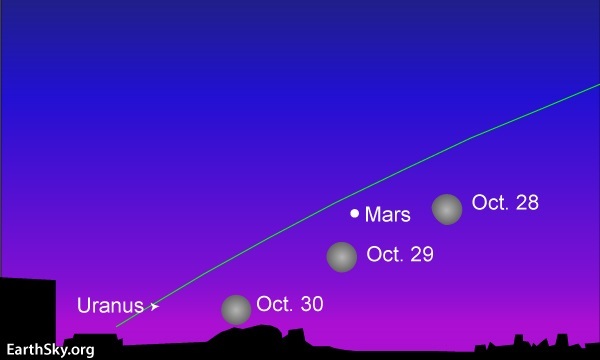Sky Report: October 26 – November 1

Often there are no planets in the evening sky, but this autumn we are fortunate to have three – plus one in the morning. Here’s where they are.
Mars and Jupiter are equally bright and they’re the first to appear as the sky grows dark. They’re on opposite sides of the sky; Mars rises in the east while Jupiter will set later in the west. They’re at the same altitude at 8 p.m. Notice the sharp difference in color; Mars is red for the same reason the hills of southern Utah are red — there is a slight amount of iron in the rocks – while Jupiter is white because it reflects sunlight without modifying it much.
Saturn is a short distance to the left of Jupiter. It’s fainter because it’s slightly smaller but mostly because it’s twice as far away. The distance between these two planets is just over 5 degrees so you can see them together in most binoculars, but this distance is decreasing nightly and they’ll be exceptionally close in two months. Remember for reference that the width of your finger held at arm’s length is about 2 degrees.
Venus rises at 5 a.m. and by 7 it’s high enough to see it well. That’s well into dawn and the stars have disappeared – but Venus remains long after they’ve gone to wherever stars go during the daytime. Venus rises a bit later each morning and we’ll lose it before the end of the year so enjoy the brilliant “morning star” while it’s still around.
The full moon on October 31 is the so-called “blue moon” and the news media hypes it as if it’s something special, but it’s simply the second full moon in the same calendar month. October’s first full moon was the Harvest Moon on the 1st, and 29.5 days later the moon is invariably full again, now on the 31st. Clearly for there to be two full moons in the same month the first has to happen on the first day of the month, and that happens once every two or three years. The term “blue moon” for the second full moon goes back only to the 1940s, so it’s not an antique term. And the moon won’t look blue. It’s a coincidence that it happens on Halloween.
The moon is near Mars on the nights of the 28th and 29th.
Photo Credit: EarthSky.org
The Sky Report is presented as a public service by the Stellar Vista Observatory, a nonprofit organization based in Kanab, Utah, which provides opportunities for people to observe, appreciate, and comprehend our starry night sky. Additional information is at www.stellarvistaobservatory.org. Send questions and comments to John@StargazingAdventures.org.






Comments are closed.